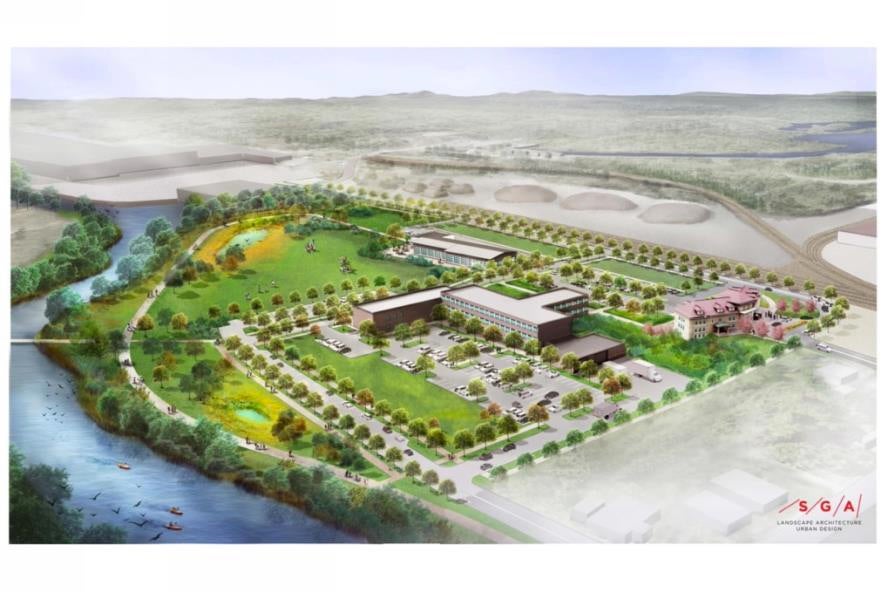Plan for bio-based heating, power system advances at Millinocket’s One North
Plan for bio-based heating, power system advances at Millinocket's One North Mainebiz


Plans for First-in-the-World Sustainable Heating and Power System

Plans have advanced to install a first-in-the-world heating and power system at the One North industrial campus being developed in Millinocket.
Fueled by the wood waste of Maine forests and cycled through a “super-critical carbon dioxide” energy conversion turbine, the system is touted as an energy-saving breakthrough.
Collaboration for Sustainable Development
Peregrine Turbine Technologies in Wiscasset is collaborating with KMW Energy Group, an Ontario manufacturer of biomass combustion systems, and Our Katahdin, the nonprofit that owns One North, to install and operate the super-critical carbon dioxide energy conversion system. The goal is to provide combined heat and power to multiple buildings on Our Katahdin’s Innovation Hub campus. The system is also expected to produce biochar for agricultural and other high-value applications.
World’s First Combined Heat and Power System
Once operational, the integrated systems will be the world’s first combined heat and power system fueled by biomass and enabled by super-critical carbon dioxide (sCO2). This innovative system aligns with the Sustainable Development Goals (SDGs) by promoting clean and affordable energy (SDG 7), responsible consumption and production (SDG 12), and climate action (SDG 13).
Financing and Support
The project has received support from the U.S. Department of Energy through congressionally directed spending of $2.5 million. This financial backing demonstrates a commitment to advancing sustainable energy solutions and achieving the SDGs.
What is sCO2?
Super-critical carbon dioxide (sCO2) occurs when carbon dioxide is held above both a critical temperature and a critical pressure. In this state, sCO2 acts like a gas but has the density of a liquid. Power cycles based on sCO2 as the working fluid can produce thermal efficiencies at lower cost than traditional power systems, leading to reduced fuel and water consumption, lower capital and electricity costs, and more compact designs.
Peregrine Turbine Technologies
Peregrine Turbine Technologies is a company focused on the development and deployment of advanced sCO2 turbine power generation, energy storage, and propulsion systems. The company’s collaboration with KMW Energy Group and Our Katahdin showcases their commitment to sustainable development and clean energy solutions.
Biomass Breakthrough
Peregrine’s sCO2 technology has achieved a breakthrough in developing a biomass solution for clean combined heat and power applications. The modular system is designed to optimize specific application requirements, making sustainable biomass energy competitive with other mainstream energy sources. This breakthrough aligns with SDG 7 (affordable and clean energy) and SDG 13 (climate action).
Benefits of the System
The system is expected to produce thermal energy and 1 megawatt of electricity, equivalent to the amount consumed by 400 to 900 homes in a year. Additionally, the system can continuously produce biochar, which has various applications in forestry, agriculture, and environmental remediation. The production of biochar also contributes to carbon sequestration, supporting SDG 13 (climate action).
Development and Collaboration
Peregrine’s sCO2 conversion system was developed in collaboration with Sandia National Laboratories, which serves the U.S. Department of Energy. The technology behind the system has been around for a while, but Peregrine’s goal was to configure a turbine system that would generate power at higher efficiency and lower cost. The use of biomass as a fuel was a natural choice due to the abundance of biomass in Maine’s forests.
SDGs, Targets, and Indicators
1. SDGs Addressed or Connected to the Issues Highlighted in the Article:
- SDG 7: Affordable and Clean Energy
- SDG 9: Industry, Innovation, and Infrastructure
- SDG 13: Climate Action
- SDG 15: Life on Land
2. Specific Targets Based on the Article’s Content:
- SDG 7.2: Increase substantially the share of renewable energy in the global energy mix.
- SDG 7.3: Double the global rate of improvement in energy efficiency.
- SDG 9.4: Upgrade infrastructure and retrofit industries to make them sustainable.
- SDG 13.2: Integrate climate change measures into national policies, strategies, and planning.
- SDG 15.2: Promote the implementation of sustainable management of all types of forests.
3. Indicators Mentioned or Implied in the Article:
- Efficiency of the super-critical carbon dioxide (sCO2) energy conversion system compared to other heat and power systems.
- Reduction in fuel and water needs due to the use of sCO2 technology.
- Capital and electricity cost savings achieved by using sCO2 technology.
- Amount of biochar produced and its potential applications in forestry and agriculture.
- Reduction in CO2 emissions through carbon sequestration with biochar production.
Table: SDGs, Targets, and Indicators
| SDGs | Targets | Indicators |
|---|---|---|
| SDG 7: Affordable and Clean Energy | 7.2: Increase substantially the share of renewable energy in the global energy mix. | – Efficiency of the sCO2 energy conversion system compared to other systems. – Reduction in fuel and water needs. |
| SDG 9: Industry, Innovation, and Infrastructure | 9.4: Upgrade infrastructure and retrofit industries to make them sustainable. | – Capital and electricity cost savings achieved by using sCO2 technology. |
| 9.4: Upgrade infrastructure and retrofit industries to make them sustainable. | – Efficiency of the sCO2 energy conversion system compared to other systems. – Reduction in fuel and water needs. |
|
| SDG 13: Climate Action | 13.2: Integrate climate change measures into national policies, strategies, and planning. | – Reduction in CO2 emissions through carbon sequestration with biochar production. |
| SDG 15: Life on Land | 15.2: Promote the implementation of sustainable management of all types of forests. | – Amount of biochar produced and its potential applications in forestry and agriculture. |
Copyright: Dive into this article, curated with care by SDG Investors Inc. Our advanced AI technology searches through vast amounts of data to spotlight how we are all moving forward with the Sustainable Development Goals. While we own the rights to this content, we invite you to share it to help spread knowledge and spark action on the SDGs.
Fuente: mainebiz.biz

Join us, as fellow seekers of change, on a transformative journey at https://sdgtalks.ai/welcome, where you can become a member and actively contribute to shaping a brighter future.







